The Nexus 7 (2013) Review
by Anand Lal Shimpi on August 22, 2013 6:00 PM ESTCPU Performance
The while the original Nexus 7 was fast for the money, the new Nexus 7 is just fast. Moving away from NVIDIA to Qualcomm, ASUS and Google settled on the APQ8064 Pro. Although we originally assumed this would be a quad-core Krait 200 based SoC, Brian's teardown revealed the part number 8064-1AA. What's special about that part number is it implies newer Krait 300 cores, making the SoC effectively a Snapdragon 600.
The CPU cores can run at up to 1.5GHz, putting it a bit lower than what we've seen from Snapdragon 600 based phones (e.g. HTC One tops out at 1.7GHz, while the US SGS4 hits 1.9GHz).
I was curious as to the impact of the lower frequency when combined with the potentially higher chassis TDP so I compared the Nexus 7 to the US Galaxy S 4. I turned to Geekbench because it offers a nicely woven mixture of single and multithreaded benchmarks, letting me look at peak available single core performance as well as what happens when multiple cores are active and working.
In this first graph we're looking at the first Krait 300 core running the workload. I've zoomed in to a small portion of the benchmark so we can get a better idea of CPU behavior:
The Nexus 7's CPU0 is almost always pegged at 1.5GHz whereas we see a lot of bursty thermal management on the smaller SGS4. This isn't unexpected, but what ends up happening is the sustained performance advantage drops from a peak theoretical max of 26% down to a more reasonable average gain of ~8%.
I was curious to see if multithreaded workloads showed any different behavior. Here we're looking at the fourth CPU core (CPU3). Note that it's not always active, which is why you see parts of the graph drop down to 0KHz. Once again we see similarly static behavior from the Nexus 7. Even with all four cores active, when you need the performance the Nexus 7 delivers a full 1.5GHz. These tests are short enough where we don't see tremendous swings in frequency, but once again we do see some frequency modulation in a smaller chassis.
The end result is that the Nexus 7's 1.5GHz Krait 300 cores are slower than what you'd get in a Galaxy S 4, however the gap isn't nearly as large as you'd expect it to be thanks to the larger chassis and how the platform is tuned. The Nexus 7 can run at 1.5GHz more consistently than Snapdragon 600 based phones can run at 1.7/1.9GHz.
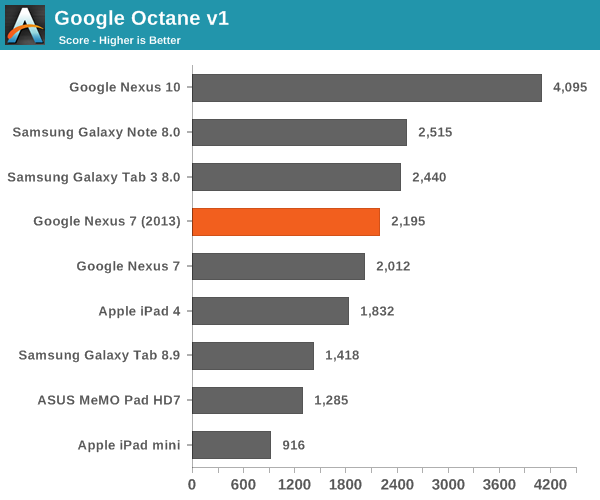


The GPU
Qualcomm seems to be frequency binning here, which is standard industry practice. Using binning to create these different SKUs gives Qualcomm pricing flexibility and also gives it the option to give large customers special treatment.
On the graphics side Qualcomm's Adreno 320 GPU makes an appearance. Clock speeds are also limited to 400MHz, compared to 450MHz for the high-end Snapdragon 600 implementations we've seen.
The APQ8064-1AA's dual-channel memory controller is populated with four x 16-bit DDR3L-1600 memory devices, giving the Nexus 7 a healthy amount of memory bandwidth. Peak memory bandwidth available to the APQ8064-1AA is 12.8GB/s, equalling what's available to Apple's A5X in the 3rd generation iPad with Retina display. Tons of memory bandwidth is obviously a pre-requisite for driving a high resolution display, and the combination of DDR3L-1600 and the Adreno 320 GPU delivers a butter smooth UI in all well written Android apps.
Although CPU performance is somewhat middle of the road compared to the rest of the landscape, GPU performance is faster than any other Nexus device on the market - and pretty much faster than any other similarly sized tablet:
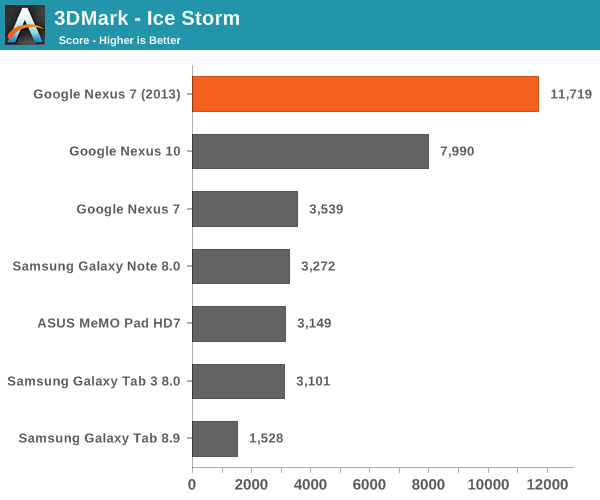
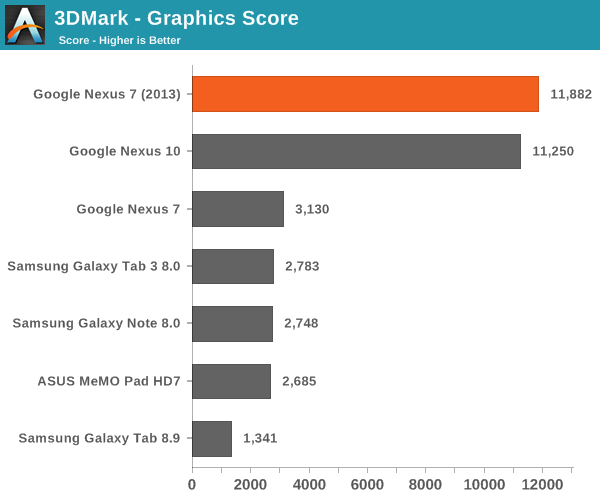
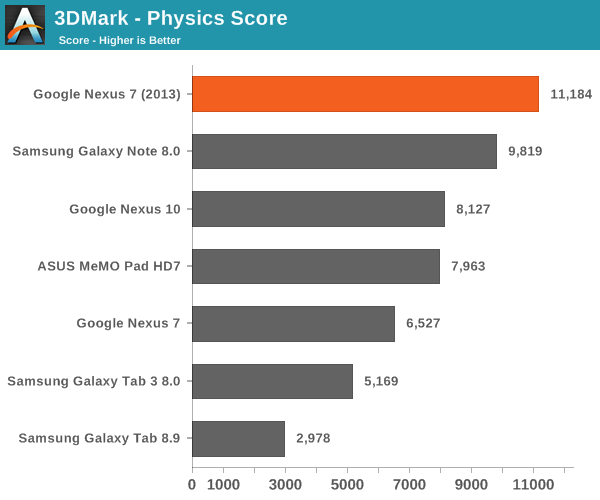
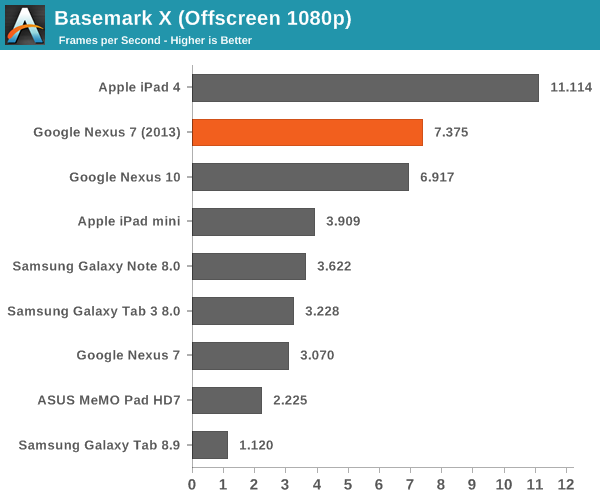
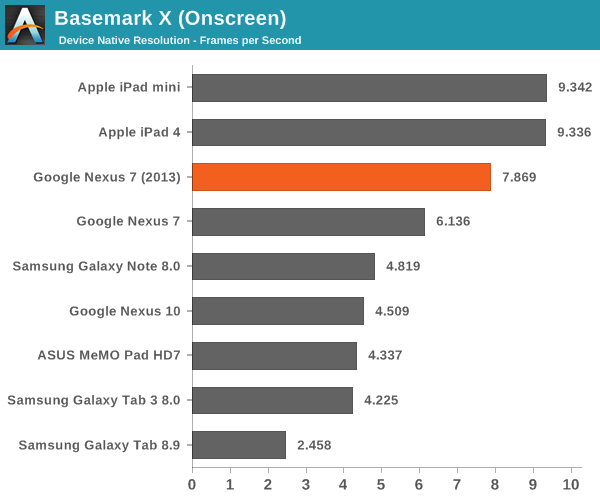
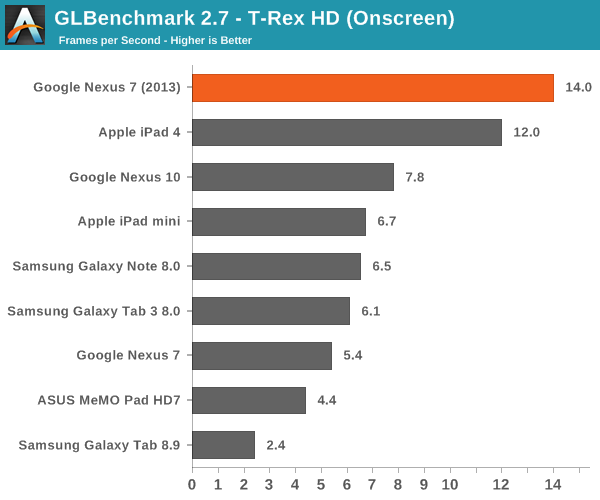
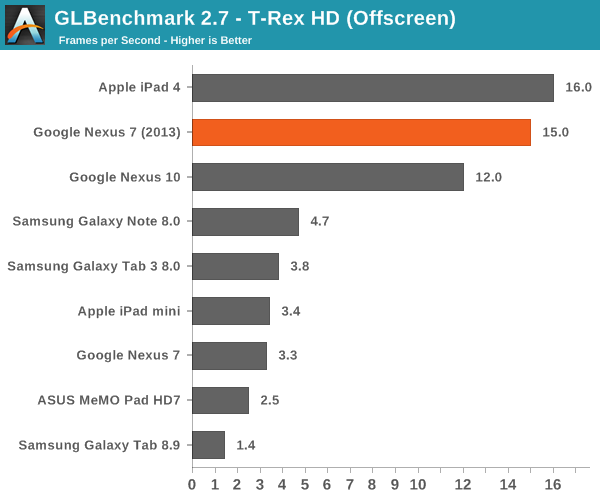
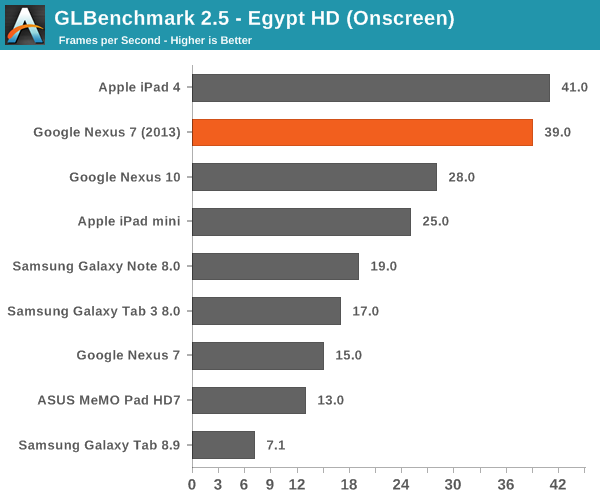
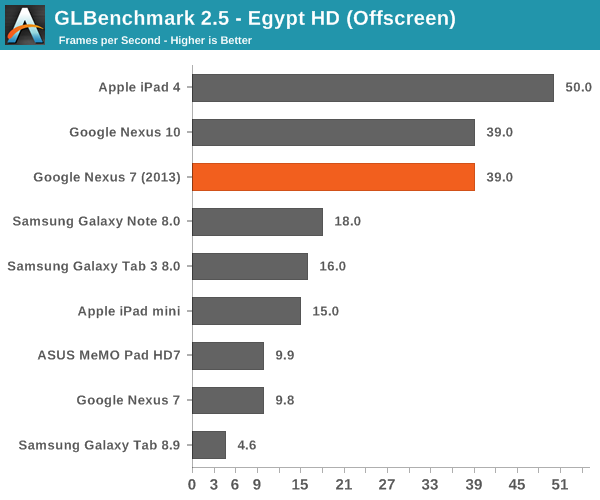
I played Modern Combat 4 as well as Shadowgun, both demanding 3D titles, on the new Nexus 7. Both titles appeared to render at the Nexus 7's native 1920 x 1200 resolution, and both appeared to do so at around 30 fps.


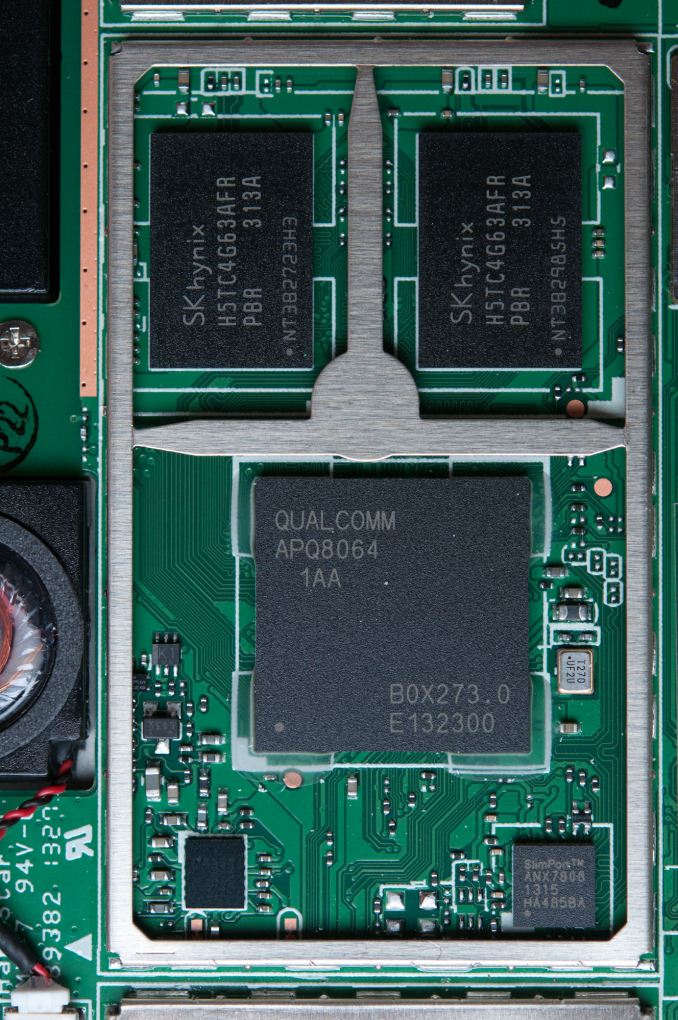
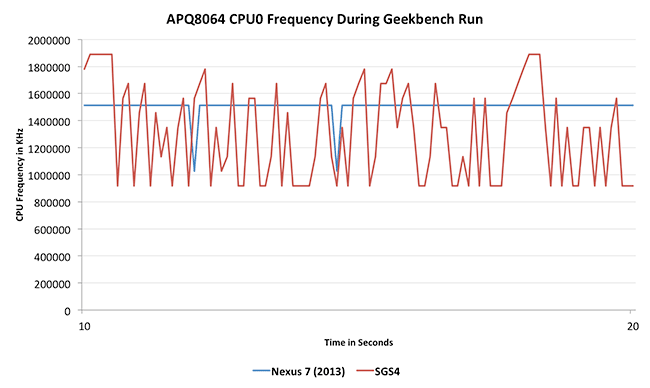
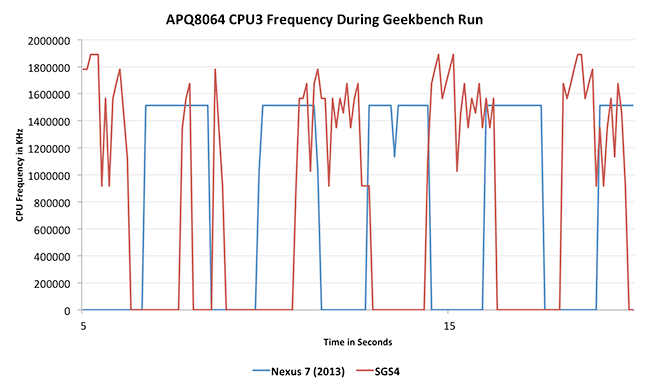








202 Comments
View All Comments
iampivot - Saturday, August 24, 2013 - link
Is the GSM modem on the 4G / LTE version locked down, so that you cannot make calls nor send SMS messages, like the original nexus 7?Shukla - Saturday, August 24, 2013 - link
Is it me or is this about 1 year behind iPad? So google puts out an iPad 4 competitor 1 year later??I'm no apple junkie but why is it that each year apple resets the bar and everyone spends the year catching up but not passing in everyway?
1. No individual app privacy controls
2. Longer battery life than iPad/iPhone (by wide margin).
I need a job with google marketing- they suck.
GTBandit22 - Saturday, August 24, 2013 - link
Well considering this is a 7 inch tablet, and half the cost of the entry level iPad, I would say you're making a bad comparison.I would say that Apple is behind in the small form factor race. 6 months behind.
akdj - Sunday, August 25, 2013 - link
Possibly because the released (Apple) their tablet nine months ago? It'll never end. They're working six months apart. With each company's current release, it'll 'best' the six month old competitors. Technology, especially low power SOC and GPU designs are developing at a rapid pace. Give it a couple months and we'll see the same thing happen with Apple's new lineup. In fact, the iPad 4 is still holding up...as is the iPhone 5 to the current crop of Android releases (other than extreme screen sizes). I like what Google is now doing with their Nexus series. Like Apple, they're designing (or helping design) the hardware and optimizing their software to work efficiently together. Super smart decision without the carrier and OEM skins we've had to live with until these new Nexus tablets have released. Smart. Idea.lightsout565 - Sunday, August 25, 2013 - link
Can someone provide me a link with a more detailed outline of how the WiFi web browsing test is conducted? Thanks!mikeyfouc - Monday, August 26, 2013 - link
Can this plug into a VGA overhead projector to mirror the screen? I'd really like to get a tablet that allows me to show Powerpoint presentations on a VGA projector. I've seen AT's review of SlimPort, but it only has a video of the mirroring on a widescreen HD TV via HDMI. Also, I've searched all over the web: can Android show powerpoint presentations in slideshow mode (as you'd see on a PC)?Shopov - Tuesday, August 27, 2013 - link
Excelent review! My question-Nexus 7 (2012) does not support WiFi Ad Hoc (ibss). This is boring since its only WiFi version (no LTE) cannot receive WiFi from tethered smartphone (mine is Nokia C-7). What about the WiFi of the new Nexus 2013? If the answer is positive this would be a big advantage. I should mention that several Android 4 tablets receive WiFi Ad Hoc (ibss).Nexus 7 2013 - Thursday, August 29, 2013 - link
For anyone considering this device, please check out the forum on Google :https://productforums.google.com/forum/#!topic/mob...
Majority are as reviewed, but a small, yet growing number are effected by software/hardware issues that, after a month's time, are yet to be concretely dealt with.
Buy only from a vendor having a good solid return/exchange /refund policy.
Hrel - Thursday, August 29, 2013 - link
No 802.11ac?! Lame."The beauty of not having to double the original Nexus 7's resolution but instead settling on an in-between option like 1920 x 1200 is that Google could get away with a performance mainstream SoC instead of something ridiculously high-end."' ... what? That's a ridiculously high resolution, Apple is stupid for thinking a resolution that high is useful.
I'd like to see them go 16:9, make the device 8" and give it a 1920x1080 display resolution. Perhaps next year, with 802.11ac.
With that said, I can't see myself even entertaining the idea of actually buying a tablet unless it's gaming focused like the Nvidia... thingy...I forget the name.
This is how I see it, tablets are secondary for web browsing in the first place, anyone in their right mind prefers using a laptop. Which, let's face it, anyone who can afford a tablet already has. So, WHY would someone buy a device where the primary focus is web browsing? Give me a tablet that's focused on mobile gaming (PSP/gameboy style) that also has all the functionality of one of these tablets, web browsing. I think Nvidia is on the right track, streaming desktop games so you can lie in bed and play without having a laptop on your chest and your wrists angled awkwardly. Play mobile games when away from home/on a plane/cab. Also allows you to read ebooks and listen to audio books AND check facebook/reddit/anandtech/twitter whatever, newegg and amazon and such.
I think if Nvidia just keeps doing what they're doing they're next gen "tablet" could be the perfect device. The only recommendation I'd make is to choose to focus on making it as good a mobile reader as an IPS display can be, it won't ever be as good as a kindle with that Eink display, but if it's close enough, and they can produce numbers to show no meaningful eye strain then I'm sold. They've gotta compete with Razer Edge, or whatever, too.
justacousin - Tuesday, September 3, 2013 - link
So what is going to be Nexus devices in improving their device?